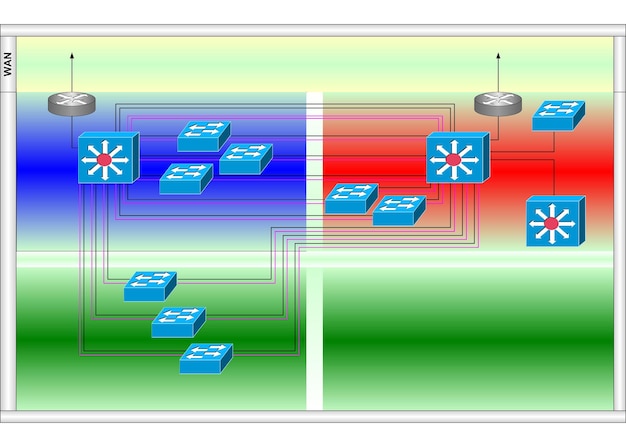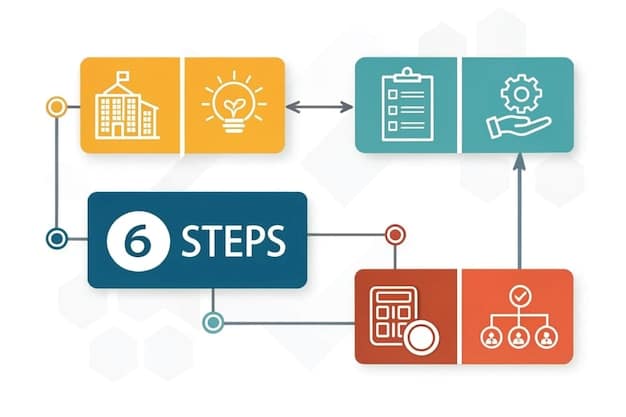Decoding DOE Grants: A 2025 Guide for Renewable Energy Startups

Decoding the Latest US Department of Energy Grants for Renewable Energy Startups: A 2025 Guide offers a comprehensive analysis of funding opportunities, eligibility criteria, and application strategies for cleantech innovators seeking DOE grants in the coming year.
Navigating the intricate landscape of government funding can be a daunting task for renewable energy startups. This guide, Decoding the Latest US Department of Energy Grants for Renewable Energy Startups: A 2025 Guide, simplifies the process.
Understanding the US Department of Energy’s Mission and Goals
The US Department of Energy (DOE) plays a pivotal role in shaping the nation’s energy future. Its mission extends beyond simply researching new energy sources; it actively promotes the development and deployment of clean, sustainable energy technologies.
DOE’s Strategic Objectives in Renewable Energy
The DOE’s renewable energy initiatives are guided by a clear set of strategic objectives. These objectives reflect a commitment to addressing climate change, enhancing energy security, and fostering economic growth through innovation.
- Reducing Carbon Emissions: A primary goal is to significantly decrease the carbon footprint of the energy sector by supporting renewable energy projects.
- Enhancing Energy Security: Diversifying energy sources and reducing dependence on fossil fuels are key priorities to bolster national energy security.
- Driving Economic Growth: The DOE aims to stimulate economic activity by investing in renewable energy technologies and creating new jobs in the cleantech sector.
- Promoting Technological Innovation: Supporting cutting-edge research and development is essential for advancing the performance and affordability of renewable energy technologies.
The DOE’s focus extends across various renewable energy sources, including solar, wind, geothermal, hydropower, and bioenergy. Each of these areas receives targeted funding and support to accelerate their development and deployment.

Key Funding Programs for Renewable Energy Startups in 2025
In 2025, the US Department of Energy (DOE) will offer a range of funding programs tailored to support renewable energy startups. These programs are designed to provide financial assistance at various stages of development, from early-stage research to commercialization.
SBIR and STTR Programs
The Small Business Innovation Research (SBIR) and Small Business Technology Transfer (STTR) programs are specifically designed to support small businesses engaged in innovative research and development. These programs offer phased funding to help startups develop and commercialize their technologies.
ARPA-E (Advanced Research Projects Agency-Energy)
ARPA-E focuses on funding high-risk, high-reward projects that have the potential to transform the energy landscape. This program is ideal for startups working on breakthrough technologies that could significantly impact energy efficiency, renewable energy, and grid modernization.
- High-Risk, High-Reward Projects: ARPA-E supports projects that may not be commercially viable in the short term but have the potential for significant long-term impact.
- Transformative Technologies: The program targets innovations that can fundamentally change the way energy is produced, stored, and used.
- Accelerated Development: ARPA-E aims to accelerate the development and deployment of advanced energy technologies through targeted funding and support.
Understanding these key funding programs and their specific requirements is essential for renewable energy startups seeking financial support from the DOE.
Eligibility Criteria for DOE Renewable Energy Grants
Navigating the eligibility criteria for DOE renewable energy grants is a critical first step for startups. These criteria ensure that funding is allocated to projects that align with the DOE’s mission and strategic goals.
Types of Eligible Organizations
The DOE typically provides funding to a variety of organizations, including small businesses, universities, research institutions, and non-profit organizations. However, eligibility requirements may vary depending on the specific funding program.
Project Requirements and Alignment with DOE Goals
To be eligible for DOE funding, projects must demonstrate a clear alignment with the agency’s strategic objectives. This includes reducing carbon emissions, enhancing energy security, and driving economic growth through technological innovation.
- Technical Feasibility: Projects must demonstrate a sound technical basis and the potential for achieving their stated goals.
- Commercial Viability: While some programs focus on early-stage research, projects should ultimately have the potential for commercialization and market adoption.
- Environmental Impact: Projects should demonstrate a positive impact on the environment, such as reducing greenhouse gas emissions or conserving natural resources.
- Economic Benefits: Projects should contribute to economic growth by creating jobs, stimulating investment, and enhancing the competitiveness of the US economy.
Meeting these eligibility criteria requires a thorough understanding of the DOE’s priorities and a well-articulated project proposal that addresses these key requirements.
Navigating the Application Process: A Step-by-Step Guide
The application process for DOE renewable energy grants can be complex and time-consuming. However, by following a structured approach, startups can increase their chances of success.
Researching Grant Opportunities
The first step is to thoroughly research available grant opportunities and identify those that align with your project’s goals and objectives. The DOE’s website, Grants.gov, and other online resources can be valuable tools for finding relevant funding opportunities.
Preparing a Compelling Proposal
A well-written and compelling proposal is essential for securing DOE funding. Your proposal should clearly articulate your project’s goals, technical approach, potential impact, and budget.
Submitting Your Application
Once your proposal is complete, you must submit it through the DOE’s online application portal. Be sure to carefully review all instructions and deadlines to ensure that your application is submitted correctly and on time.

Maximizing Your Chances of Success
Securing DOE funding requires more than just a technically sound project. Startups must also demonstrate a clear understanding of the market, a strong management team, and a well-defined commercialization strategy.
Building a Strong Team
A strong management team with relevant experience and expertise is essential for attracting DOE funding. Your team should include individuals with skills in technology development, business management, and fundraising.
Developing a Commercialization Strategy
The DOE is interested in funding projects that have the potential for commercial success. Your proposal should include a clear and well-defined commercialization strategy that outlines how your technology will be brought to market.
- Market Analysis: Conduct a thorough market analysis to identify potential customers, competitors, and market trends.
- Business Model: Develop a sustainable business model that outlines how your company will generate revenue and achieve profitability.
- Partnerships: Establish strategic partnerships with industry stakeholders, universities, and other organizations to enhance your commercialization prospects.
By focusing on these key factors, renewable energy startups can significantly increase their chances of securing DOE funding and bringing their innovative technologies to market.
Looking Ahead: Trends and Future Opportunities in Renewable Energy Funding
The landscape of renewable energy funding is constantly evolving, driven by technological advancements, policy changes, and market forces. Staying informed about these trends is crucial for startups seeking to secure funding and remain competitive.
Emerging Technologies and Focus Areas for Funding
The DOE is increasingly focused on funding emerging technologies that have the potential to transform the energy sector. This includes areas such as energy storage, advanced materials, and artificial intelligence for energy management.
- Energy Storage: Developing advanced energy storage solutions is a key priority for the DOE, as it enables greater integration of renewable energy sources into the grid.
- Advanced Materials: Researching and developing new materials that improve the performance and durability of renewable energy technologies is also a focus area.
- AI for Energy Management: Applying artificial intelligence and machine learning to optimize energy production, distribution, and consumption is gaining increasing attention.
Policy and Regulatory Changes Impacting Funding Priorities
Changes in government policy and regulations can significantly impact funding priorities for renewable energy. Startups should closely monitor these developments to ensure that their projects align with the DOE’s evolving priorities.
By staying informed about these trends and adapting their strategies accordingly, renewable energy startups can position themselves for success in the ever-changing landscape of government funding.
| Key Point | Brief Description |
|---|---|
| 💡 DOE’s Mission | Promoting clean, sustainable energy technologies. |
| 💰 Key Programs | SBIR, STTR, and ARPA-E offer funding opportunities. |
| ✅ Eligibility | Alignment with DOE goals is crucial. |
| 📈 Maximizing Success | Build a strong team and commercialization plan. |
Frequently Asked Questions
▼
The DOE funds a wide array of projects, including solar, wind, geothermal, hydropower, and bioenergy initiatives. Projects that demonstrate innovation and potential for commercialization are often favored.
▼
Building a strong team, developing a clear commercialization strategy, and demonstrating alignment with the DOE’s goals are crucial. A well-written and compelling proposal is also essential.
▼
ARPA-E focuses on high-risk, high-reward projects that have the potential to transform the energy landscape. It supports breakthrough technologies that may not be commercially viable in the short term.
▼
Yes, the SBIR and STTR programs are specifically designed to support small businesses engaged in innovative research and development. These programs offer phased funding to help startups.
▼
The DOE releases new funding opportunities on a regular basis. Startups should monitor the DOE’s website and Grants.gov for announcements of new programs and deadlines.
Conclusion
Navigating the landscape of DOE grants for renewable energy startups requires a strategic approach, a strong team, and a commitment to innovation. By understanding the DOE’s mission, key funding programs, and eligibility criteria, startups can position themselves for success in securing the funding they need to bring their transformative technologies to market.




